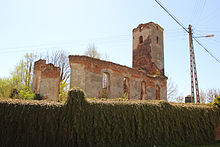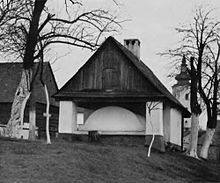Rozumice
| Rozumice | ||
|---|---|---|

|
|
|
| Basic data | ||
| State : | Poland | |
| Voivodeship : | Opole | |
| Powiat : | Głubczyce | |
| Gmina : | Kietrz | |
| Geographic location : | 50 ° 1 ′ N , 17 ° 59 ′ E | |
| Residents : | 331 (2010) | |
| Telephone code : | (+48) 77 | |
| License plate : | OGL | |
Rozumice (German Rösnitz ) is a village in Upper Silesia , near the Czech border. Rozumice is located in the municipality of Kietrz (Katscher) in the powiat Głubczycki in the Polish Opole Voivodeship . The place has about 330 inhabitants.
geography

Rozumice is eight kilometers south of the Kietrz municipality, 23 kilometers southeast of the district town of Głubczyce (Leobschütz) and 73 kilometers south of the voivodeship capital Opole (Opole) .
history
Colonists from Central Germany immigrated to this area as early as 1250. The place was first mentioned in 1335 with the name Resenitz. It belonged to the Duchy of Opava, which had been independent since 1318 . Divisions of inheritance and political changes established a checkered local history. In 1422, Czech was introduced as the official language throughout the Duchy of Opava , and from 1430 the place was called Rosumicz ( Rozum = Moravian: understanding; Rosumicze = place of the wise). However, the residents have probably never completely given up the German language, and from 1612 the name Rosnitz or Rösnitz was used. The Hussite Wars , the Thirty Years' War and the Silesian Wars put great stress on the residents. With the Peace of Berlin (1742) almost all of Silesia, including Rösnitz, fell to Prussia . Old legal rights from the 16th century to exemption from taxes were further confirmed by the Prussian government. The rulership structure in the village changed frequently until finally in 1816 the last owner, Ernst Joachim Graf von Strachwitz, left the place to the community for 22,000 thalers. In this way a certain prosperity could gradually spread.
From around 1880, Rösnitz was considered the richest village in the Leobschütz district with a later almost urban-looking, developed, rural infrastructure. Distilleries, water, wind and oil mills are also mentioned. From an administrative point of view , the municipality had belonged to the Piltsch district since 1874 , before it formed the Rösnitz district together with Steuberwitz (Ściborzyce Wielkie) from 1932 . In the referendum in Upper Silesia on March 20, 1921, the district, including Rösnitz, voted with a clear majority to remain with Germany. In 1933 there were 1,043 inhabitants in Rösnitz.
At the end of the Second World War , Rösnitz was occupied by the Red Army after heavy fighting and came to Poland . The German residents who fled together on March 24, 1945 returned after about a month and a half and found a desert of rubble. The task of the returnees was to make the place habitable, to remove the worst consequences of the war and to do field work. They later had to vacate their accommodations and were deported to Germany with 50 kg of luggage each from July 5 to 14, 1946 . This created space for the new Polish residents who were driven here from what are now Soviet areas . The Polish administration introduced the current place name in 1945 and subordinated the place first to the Silesian Voivodeship , before it came to the Opole Voivodeship in 1950 . The current local subordination within the Powiat Głubczycki has existed since 1999.
The former German residents of Rösnitz, who are still alive today, and their descendants maintain friendly contacts with today's Polish residents of Rozumice.
Church affiliation
In 1526 the Lutheran faith was able to gain a foothold in this region. Social changes took hold under various Lutheran rulers. From 1557 onwards, the residents were able to acquire the property rights for their houses and the cultivated land, free themselves from serfdom and from tithing. There was a school since 1575 and an evangelical school since 1582. In 1580 the Protestant church was built. The residents, together with the neighboring town of Steuberwitz, successfully withstood the recatholization that began in the Thirty Years' War, and the Jesuit order, established for this purpose from 1667 to 1678, was unable to change this. Since the church remained closed to the residents during this time, they celebrated secret devotions in a hidden place in the forest, which is still called the pulpit today.
Under the Prussian government, freedom of belief was secured in a house of prayer before the congregation received the church back after a court ruling in 1801, although it was replaced by a new baroque building in 1807.
The Bohemian Brothers had numerous followers in Rösnitz, and the founder of the Moravian Brethren , Nikolaus Ludwig von Zinzendorf , visited the place as early as 1726. Later the Moravians tried to found a Brothers' Unity in Rösnitz , but this failed due to the resistance of the rival Lutheran regional church.
During the Nazi era, Pastor Arnold Hitzer , a member of the Confessing Church, worked in the Rösnitz congregation .
The Rösnitz church was badly destroyed in the Second World War and is now a ruin in the center of the village. Eventually it should be secured so that it is accessible for devotional purposes. One of the bells of the Rösnitzer Church escaped being melted down in the Second World War and is ringing today in the Nicolaikirche of the Vorhelm community , Agnes-Miegel-Str. 14th
With the expulsion of the German residents in Rösnitz in 1946, a 420-year-old Protestant tradition was lost. Today's residents are predominantly Catholic.
Attractions
- Historic village complex as an anger village with typical Franconian farms. This construction is no longer consistently recognizable today.
- As a secured architectural monument, a last remaining Laimes - a granary and storage facility. In 1934 there were 20 of these windowless buildings.
- Ruins of the former Protestant church as an impressive memorial.
- In the adjoining churchyard, the former German memorial for those who fell in World War I was given an inscription in Polish and German, saying “Never again war” and is now also used as a memorial.
- There are two important nature reserves near the village, to the southeast the Rezerwat przyrody Rozumice forest reserve and to the north the Góra Gipsowa nature reserve with its Pontic steppe flora.
coat of arms
Old seals and stamps of the place show a single rose. Thus it is a talking coat of arms .
Personalities
- Martin Fiebig (1891–1947), General of the Air Force
- Hans Langener , b. 1865 in Rösnitz, landscape painter in Dortmund
- Alexander von Wartensleben-Schwirsen (1807-1883), member of a Mecklenburg noble family, born in Rösnitz, member of the Frankfurt National Assembly , conservative Prussian member of parliament
- Arnold Hitzer (1902–1977), Evangelical Lutheran pastor from 1928 to 1939 in Rösnitz, member of the Confessing Church
literature
- Court judge: local history district Leobschütz, extract: Rösnitz . Upper Silesia in Pictures, January 2, 1931, No. 1, pp. 4–5.
- Richard Keilholz: An oil press in Rösnitz . Der Oberschlesier 1931, No. 13/2, pp. 71–73.
- Max Krömer: The Leobschützer Angerdorf Rösnitz . Upper Silesia in Pictures, September 22, 1932, No. 39, p. 2.
- Max Krömer: The Rösnitzer Laimes, a peculiar Upper Silesian building . Upper Silesia in Pictures, November 8, 1934, No. 45, pp. 2, 5.
- Joachim Köhler, Rainer Bendel (eds.): History of religion in East Central and Southern Europe, Volume I, History of Christian life in the Silesian region, Part 1, Dietrich Meyer: The Pietism and the Catholic Church in Silesia . LIT Verlag, Münster / Hamburg / London 2002, ISBN 3-8258-5007-2 .
- Krzysztof Gładkowski: Protestanci na ziemi Głubczyckiej . Kalendarz Głubczycki, 2006, pp. 109–114.
- Krzysztof Gładkowski: Pulpit, ambona - Protestancka Wspólnota Lokalna na Górnym Śląsku . Wydawnictwo Uniwersytatu Warmińsko-Mazurskiego, Olsztynie 2008.
Web links
Individual evidence
- ↑ Główny Urząd Statystyczny: Portret miejscowości statystycznych w gminie Kietrz (powiat głubczycki, województwo opolskie) w 2010 r. Online query
- ↑ The von Strachwitz are an ancient, widely branched, Silesian noble family, who from 1800 owned the nearby Castle Krawarn as their residence.
- ^ Rolf Jehke: Territorial changes in Germany and German administered areas 1874-1945, district Piltsch . http://www.territorial.de/obschles/leobsch/piltsch.htm , accessed on May 28, 2012.
- ^ Rolf Jehke: Territorial changes in Germany and German administered areas 1874–1945, District Rösnitz . http://www.territorial.de/obschles/leobsch/roesnitz.htm , accessed on May 28, 2012.
- ^ Michael Rademacher: German administrative history from the unification of the empire in 1871 to the reunification in 1990. Leobschütz district (Polish Glubczyce). (Online material for the dissertation, Osnabrück 2006).
- ^ B. Dudek: Library and archive in the prince archbishop's palace at Kremsier . Wilhelm Braumeister, court and university bookseller, Vienna 1870, p. 47.
- ↑ Kirchengemeinde Sendenhorst - Nicolaikirche ( Memento of the original from December 16, 2016 in the Internet Archive ) Info: The archive link has been inserted automatically and has not yet been checked. Please check the original and archive link according to the instructions and then remove this notice. , accessed May 25, 2012.
- ↑ Hans Wolfgang Singer (Ed.): General Artist Lexicon . Volume 6, Rütten & Loening, Frankfurt a. M. 1932, p. 132.






